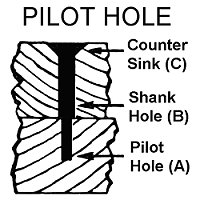
Wood Screw Pilot Hole Sizes
When joining wood with screws, it is necessary to bore pilot holes. Pilot holes make screws easier to drive and there is less chance of damaging the screws or wood. Bore holes large enough to freely accommodate the screw shank in the first piece of wood. Bore holes slightly smaller than the thread diameter, to a depth of half the length of the threaded portion in the second piece of wood.
| No. of Screw |
Pilot Holes (A) | Shank Clearance Holes (B) | Counter sink (C) |
||||
|---|---|---|---|---|---|---|---|
| Hardwoods | Softwoods | Twist bit (Nearest size in fractions of an inch |
Drill Gauge No. or Letter To be used for maximum holding power |
No. of Auger Bit To counterbore for sinking head (by 1/16ths) |
|||
| Twist bit (Nearest size in fractions of an inch) |
Drill Gauge No. To be used for maximum holding power |
Twist bit (Nearest size in fractions of an inch) |
Drill Gauge No. To be used for maximum holding power |
||||
| 6 | - | 44 | 1/16 | 52 | 9/64 | 27 | 5 |
| 7 | - | 39 | 1/16 | 51 | 5/32 | 22 | 5 |
| 8 | 7/64 | 35 | 5/64 | 48 | 11/64 | 18 | 6 |
| 9 | 7/64 | 33 | 5/64 | 45 | 3/16 | 14 | 6 |
| 10 | 1/8 | 31 | 3/32 | 43 | 3/16 | 10 | 6 |
| 11 | - | 29 | 3/32 | 40 | 13/64 | 4 | 7 |
| 12 | - | 25 | 7/64 | 38 | 7/32 | 2 | 7 |
| 14 | 3/32 | 14 | 7/64 | 32 | 1/4 | D | 8 |
| 16 | - | 10 | 9/64 | 29 | 17/64 | I | 9 |
| 18 | 13/64 | 6 | 9/64 | 26 | 19/64 | N | 10 |
Plate 6B - Wood Screw Chart